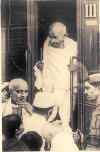

Independence brought glory to the country. EIR in its attempt to
share the joy also faced the post independence trauma of separation. On the
other hand, it got appended by the truncated Sealdah division of B & A Railway
having interchange points with East Pakistan (presently Bangladesh)
at Bongaon and Ranaghat. Kanchrapara Workshop, Loco sheds at Calcutta and Chitpur and Stores depot at Halisahar became part of EIR.
This momentous occasion has been rightly described by the then GM of EIR Khan Bahadur Ghulam Faruque, who later became Chairman of Pakistan Railway Board, and Governor of East Pakistan (now Bangladesh).
|
This
day,
|
Division of assets and staff of the erstwhile B & A Railway caused many problems. The most traumatic event was the inflow of refugees from East Pakistan. They occupied every inch of space near the major stations around Calcutta with their meagre belongings.
Refugees were vacated from station in 1957, in preparation for the inauguration of electric suburban trains, but in Sealdah they stayed for another two decades until they were rehabilitated in Madhya Pradesh.

The tragic Bihar earthquake of 1934 prompted the Mahatma to make his second visit to Patna by rail in March 1934 to tour the earthquake affected areas of Bihar for assuaging the traumatized masses
He had to cut short this visit and rush back to to meet the Viceroy Lord Mountbatten after getting an urgent message. Gandhiji refused the Viceroy’s offer of a private aircraft and insisted on travelling by train — third class !
|
|
|
GM, EIR V. Nilakantan addressing the condolence meeting on the death of Gandhiji |
After the assassination of the Father of the Nation which shook the world on 30 January, 1948 the EIR observed two minutes silence and paid homage to the Mahatma in its Headquarters. The then General Manager of EIR, V. Nilakantan addressed a condolence meeting where rich tributes were paid to
“one, if not the greatest man that the world has produced”.The real tribute to Mahatma Gandhi from EIR came in the form of introduction of an exclusively third class express train named ‘Janta Express’ on 1st October 1948 which initially ran between Patna and Delhi but was extended upto Howrah in 1949. this was the first Janta Express train of the country. GIP followed EIR’s example and started this Janta Express soon after.